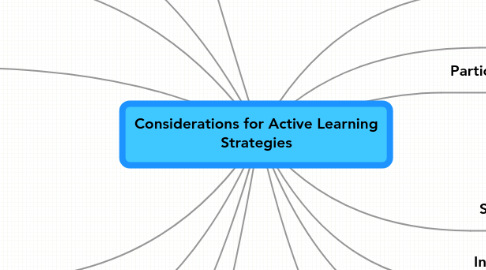
1. Community
1.1. forms bonds between students
1.1.1. increases learnning outside of class, too e.g. students may form study groups
2. Learning
2.1. Increases higher order thinking
3. Instructor Presence
3.1. What ideas do you have here?
4. Participation/Motivation
4.1. Will students come to class?
4.1.1. Need to motivate students who prefer/expect to take a passive role in class.
4.1.1.1. Strategy: Highlight value of teamwork in the workplace.
4.1.1.2. Strategy: Share research about effectiveness of active learning
4.1.1.3. Strategy: Emphasize learning goals related to higher order thinking and alignment of active learning with those goals.
4.1.1.4. Strategy: Start active learning on Day 1, don't let a culture of passivity become established in the first days of your class.
5. Instructor Workload
5.1. Increased
5.1.1. Generating good questions can be time consuming
5.1.1.1. Strategy: (Ball) Start slow/small
5.1.1.2. Strategy: Learn from your mistakes, the second time will be better than the first
5.1.1.3. Strategy: Use student generated questions
5.1.1.4. Strategy: Collect questions on index cards, develop a deck of questions you can reuse
5.1.2. Need to come up with a Plan B in case activities don't work out
5.2. depends on comfort level with "winging it" - and dealing with unexpected situations
5.3. instructor's role changes - more of a moderator role
5.4. What support is available?
5.4.1. GSIs or other instructors?
6. Student Workload
6.1. Will some students be free riders, remain passive in group activities?
6.1.1. Strategy: individual assessments (clickers, quizzes, return to individual assessment after group work)
7. Tech Management
7.1. Does the classroom space support the activities?
7.1.1. fixed vs. movable seating?
7.1.2. Sufficient power outlets?
7.1.3. adequate wifi for number of users, bandwidth needed?
7.1.4. Appropriate lighting?
7.1.5. Shared spaces present a challenge if instructor cannot always control the room resources/configuration.
8. Active Learning Techniques
8.1. Face-to-face Think-Pair-Share
8.1.1. Deborah Ball example
8.1.2. Eric Mazur example
8.2. Online Discussion
8.2.1. Breakout rooms in Collaborate
8.2.2. group or individual blogs
8.2.2.1. option: assign teams of students to blog together
8.2.3. forums e.g., CTools forums
8.2.3.1. option: assign roles to students within the forum
8.2.4. Google Docs
8.2.4.1. option: combine with video chat, e.g., Google+ Hangout
9. Learning
9.1. Can activities be tailored for students?
9.1.1. Strategy: earn student background (course content and tech skills)
10. Community
11. Participation/Motivation
12. Student Workload
13. Instructor Presence
14. Instructor Workload
14.1. Establish course policies, flowcharts for key processes
14.1.1. School as a whole should have ppolicies, procedures, too
14.1.2. Communicate policies to students
14.1.2.1. Be sure they know how to get support
15. Tech Management
15.1. What support is available?
15.1.1. Available instrstructure at home and at school
15.1.2. Support for studetns
15.1.3. SoN IT Team knowledge base
15.1.3.1. Attendance at faculty events E.G., NDTI is helpful for SoN IT to support faculty
